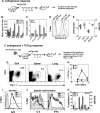Multifunctional CD4 cells expressing gamma interferon and perforin mediate protection against lethal influenza virus infection
- PMID: 22491469
- PMCID: PMC3393557
- DOI: 10.1128/JVI.07172-11
Multifunctional CD4 cells expressing gamma interferon and perforin mediate protection against lethal influenza virus infection
Abstract
CD4 effectors generated in vitro can promote survival against a highly pathogenic influenza virus via an antibody-independent mechanism involving class II-restricted, perforin-mediated cytotoxicity. However, it is not known whether CD4 cells activated during influenza virus infection can acquire cytolytic activity that contributes to protection against lethal challenge. CD4 cells isolated from the lungs of infected mice were able to confer protection against a lethal dose of H1N1 influenza virus A/Puerto Rico 8/34 (PR8). Infection of BALB/c mice with PR8 induced a multifunctional CD4 population with proliferative capacity and ability to secrete interleukin-2 (IL-2) and tumor necrosis factor alpha (TNF-α) in the draining lymph node (DLN) and gamma interferon (IFN-γ) and IL-10 in the lung. IFN-γ-deficient CD4 cells produced larger amounts of IL-17 and similar levels of TNF-α, IL-10, and IL-2 compared to wild-type (WT) CD4 cells. Both WT and IFN-γ(-/-) CD4 cells exhibit influenza virus-specific cytotoxicity; however, IFN-γ-deficient CD4 cells did not promote recovery after lethal infection as effectively as WT CD4 cells. PR8 infection induced a population of cytolytic CD4 effectors that resided in the lung but not the DLN. These cells expressed granzyme B (GrB) and required perforin to lyse peptide-pulsed targets. Lethally infected mice given influenza virus-specific CD4 cells deficient in perforin showed greater weight loss and a slower time to recovery than mice given WT influenza virus-specific CD4 cells. Taken together, these data strengthen the concept that CD4 T cell effectors are broadly multifunctional with direct roles in promoting protection against lethal influenza virus infection.
Figures







References
Publication types
MeSH terms
Substances
Grants and funding
LinkOut - more resources
Full Text Sources
Other Literature Sources
Research Materials

